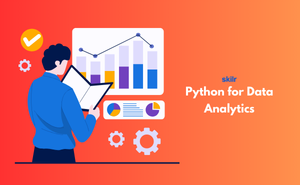👇 CELEBRATE CLOUD SECURITY DAY 👇
00
HOURS
00
MINUTES
00
SECONDS

Python in Data Analytics means applying Python’s programming power to explore and analyze data. With its wide range of libraries, Python makes tasks like filtering data, performing calculations, and generating charts very simple. It is widely used because it is easy to learn and works well for both small-scale reports and large-scale analysis.
Think of Python as a digital toolbox that helps professionals transform raw numbers into clear insights. It not only saves time but also makes analysis more accurate and advanced, supporting everything from business reports to predictive analytics. That’s why Python has become one of the most popular languages for data-focused careers.
This exam is ideal for:
Industry-endorsed certificates to strengthen your career profile.
Start learning immediately with digital materials, no delays.
Practice until you’re fully confident, at no additional charge.
Study anytime, anywhere, on laptop, tablet, or smartphone.
Courses and practice exams developed by qualified professionals.
Support available round the clock whenever you need help.
Easy-to-follow content with practice exams and assessments.
Join a global community of professionals advancing their skills.
Yes, basics of predictive modeling will be covered.
It’s the use of Python programming to analyze, visualize, and interpret data.
Students, analysts, and professionals who want to build data analytics skills.
Basic knowledge helps, but beginners can also learn from scratch.
It’s simple, powerful, and has many libraries designed for data work.
Finance, healthcare, marketing, e-commerce, and technology.
Pandas, NumPy, Matplotlib, and Seaborn.
Yes, creating charts and visual insights is a major part of the course.
Yes, with extensions like PySpark, Python can handle large datasets.
Python automates tasks, handles bigger data, and provides advanced analytics.